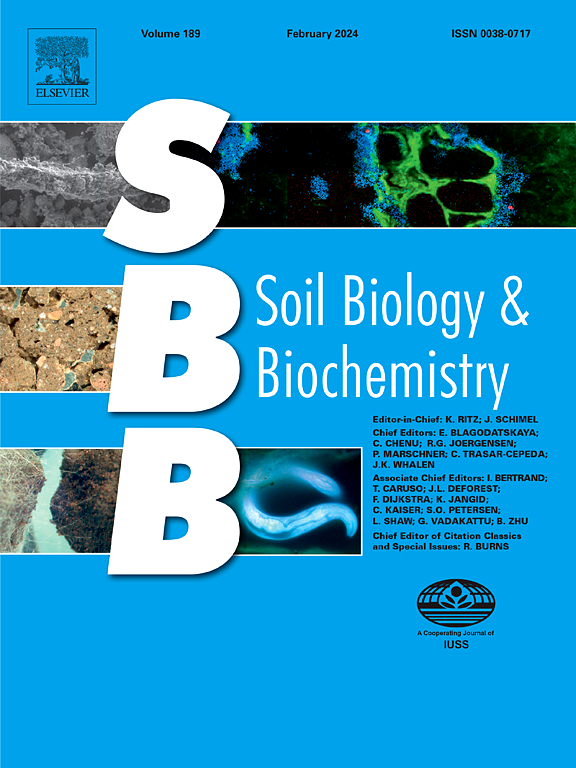氮引起的土壤碳增量在停止过量氮输入后不易流失
IF 9.8
1区 农林科学
Q1 SOIL SCIENCE
引用次数: 0
摘要
氮(N)沉积通过减少微生物分解增加了美国东部温带森林的土壤碳(C)储存。然而,由于氮沉降率的大幅下降和土壤温度的升高,这些由氮引起的土壤碳增加的命运并不确定。由于氮沉积降低了土壤 pH 值,减少了植物对根圈的碳投资,因此我们比较了通过提高土壤 pH 值、添加人工根系渗出物或提高土壤温度来消除对微生物分解的限制,将在多大程度上增加氮输入过量和未输入过量的土壤中的微生物分解。我们假设,减轻这些微生物分解的限制将减少土壤中过量氮的流失。为了验证这一假设,我们在西弗吉尼亚州费尔诺实验森林进行了一项为期 30 年的氮沉积实验,实验结束 4 年后,我们对未施肥流域和之前施过氮肥流域的土壤中的微生物呼吸、微生物生物量和土壤酶活性进行了比较。我们发现,在这两个流域中,消除 pH 值、植物碳或温度对分解的限制都会刺激微生物呼吸。然而,在以前施过氮肥的流域,所有处理中的微生物分解和土壤碳损失都一直较低。这种反应,再加上不同流域和处理之间微生物生物量没有差异,表明长期施氮肥从根本上改变了土壤微生物群落,导致微生物群落分解土壤有机物的能力持续下降。总之,我们的研究结果表明,氮沉积对微生物群落的遗留效应可能会影响土壤碳储量在全球变化中的持久性。本文章由计算机程序翻译,如有差异,请以英文原文为准。
Nitrogen induced soil carbon gains are resistant to loss after the cessation of excess nitrogen inputs
Nitrogen (N) deposition has increased soil carbon (C) storage across eastern US temperate forests by reducing microbial decomposition. However, the fate of these N-induced soil C gains are uncertain given strong declines in N-deposition rates and rising soil temperatures. As N deposition has reduced soil pH and plant C investments into the rhizosphere, we compared the extent to which removing limitations to microbial decomposition by increasing soil pH, adding artificial root exudates, or elevating soil temperature would increase microbial decomposition in soils that have and have not received excess N inputs. We hypothesized that alleviating these microbial decomposition limitations would prime soil C losses from soils that have received excess N inputs. To test this hypothesis, we conducted a soil microcosm experiment where we compared microbial respiration, microbial biomass, and soil enzyme activity in soils from an unfertilized watershed and a previously N-fertilized watershed 4 years after the end of a 30-year N deposition experiment at the Fernow Experimental Forest in West Virginia. In both watersheds, we found that removing pH, plant carbon, or temperature limitations to decomposition stimulated microbial respiration. However, microbial decomposition and soil C losses were consistently lower in the previously N-fertilized watershed across all treatments. This response, coupled with a lack of differences in microbial biomass between watersheds and treatments, suggests that long-term N fertilization has fundamentally altered soil microbial communities and has led to a sustained impairment of the ability of the microbial community to decompose soil organic matter. Collectively, our results indicate that the legacy effect of N deposition on microbial communities may influence the persistence of soil C stocks in the face of global change.
求助全文
通过发布文献求助,成功后即可免费获取论文全文。
去求助
来源期刊

Soil Biology & Biochemistry
农林科学-土壤科学
CiteScore
16.90
自引率
9.30%
发文量
312
审稿时长
49 days
期刊介绍:
Soil Biology & Biochemistry publishes original research articles of international significance focusing on biological processes in soil and their applications to soil and environmental quality. Major topics include the ecology and biochemical processes of soil organisms, their effects on the environment, and interactions with plants. The journal also welcomes state-of-the-art reviews and discussions on contemporary research in soil biology and biochemistry.
 求助内容:
求助内容: 应助结果提醒方式:
应助结果提醒方式:


